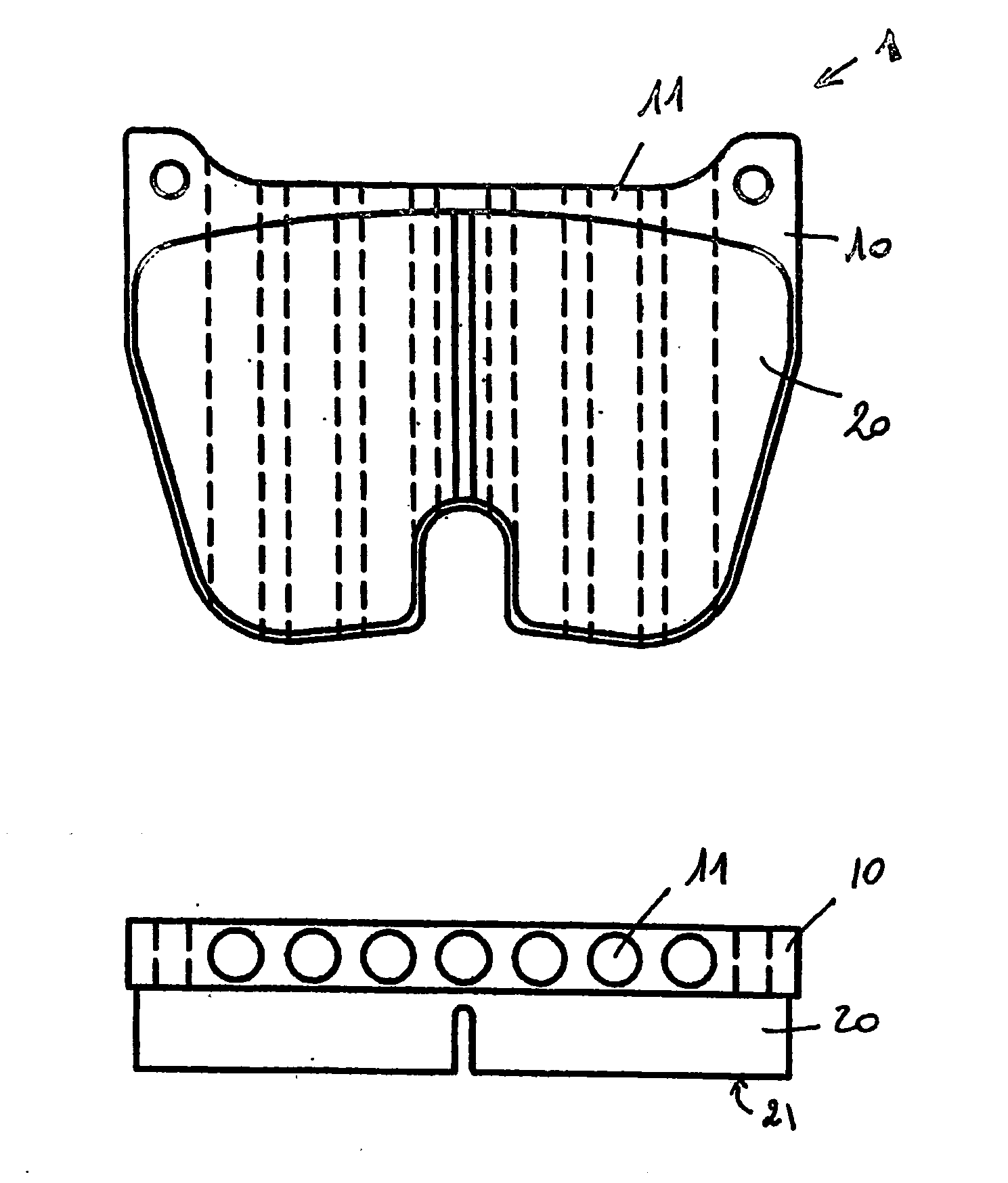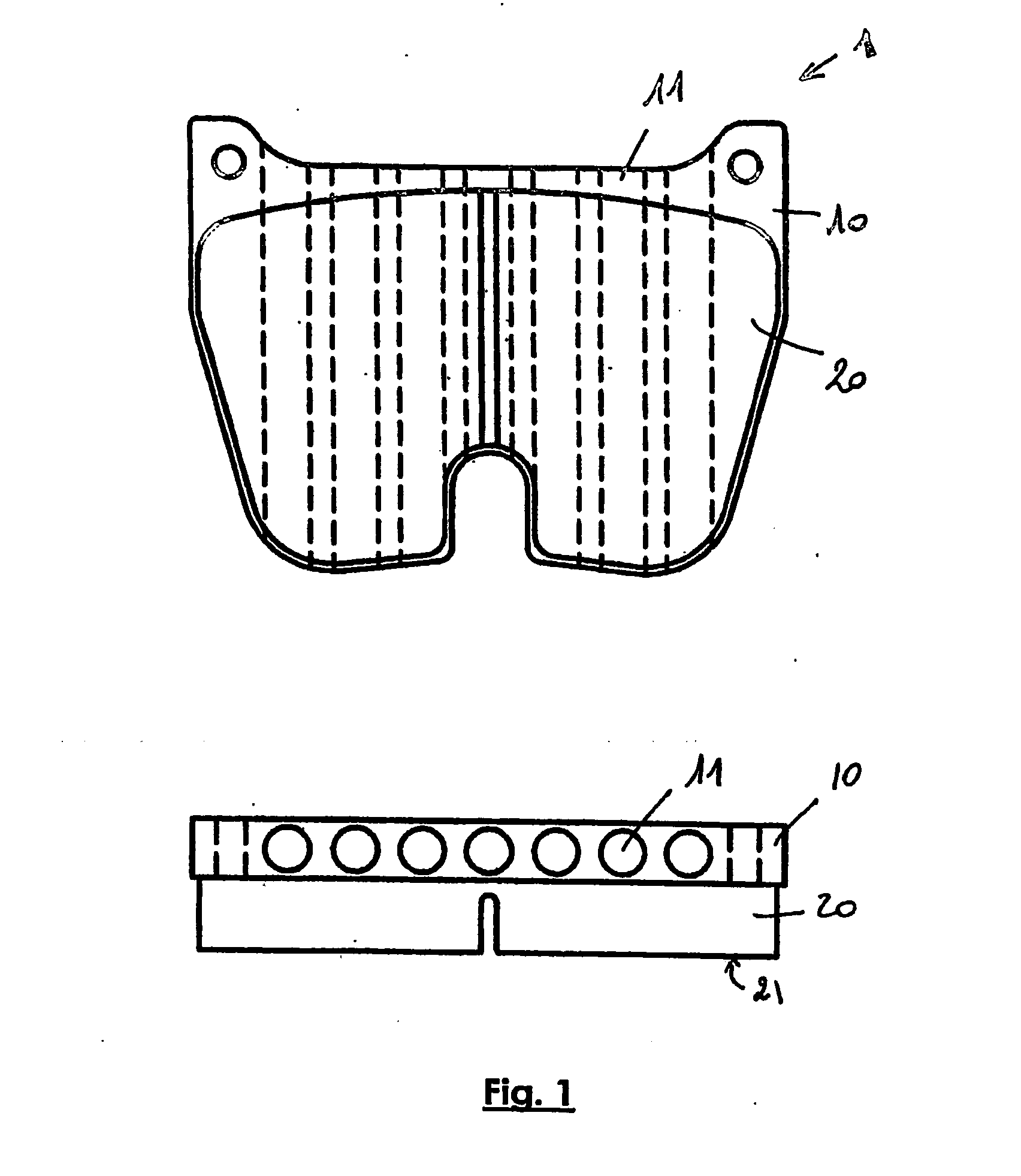Ventilated brake pads
a technology of brake pads and ventilation, which is applied in the direction of brake systems, mechanical devices, transportation and packaging, etc., can solve the problems of brake malfunction, kinetic energy, intense temperature rise, etc., and achieve the effect of improving the exchange surface area, facilitating heat flux transfer, and improving the compromise between ventilation and mechanical strength
- Summary
- Abstract
- Description
- Claims
- Application Information
AI Technical Summary
Benefits of technology
Problems solved by technology
Method used
Image
Examples
example 1
Pad with a Perforated Carrier Plate (FIG. 1)
[0024]FIG. 1 shows a disc brake pad 1 with a steel carrier plate 10 and a sintered brake lining 20 that has a plane surface 21 that will come into friction contact on one face of the disk, called the friction surface. The brake lining 20 is fixed to the carrier plate 10 by brazing.
[0025] The heat dissipating structure is obtained by perforating holes 11 in the carrier plate 10 along a direction substantially parallel to the friction surface 21. These holes are through holes; they pass through the carrier plate 10 from one side to the other such that air can pass through them freely. They are cylindrical holes parallel to each other and with an axis substantially parallel to the plane of the friction surface. These holes are oriented parallel to the air inlet.
[0026] The thickness of the carrier plate 10 is typically 8 mm and it is inscribed within an substantially 80*60 mm rectangle. The diameter of the seven holes 11 is 6 mm, so that th...
example 2
Pad with a Ventilated Lining (FIG. 2)
[0027]FIG. 2 shows a disc brake pad 100 with a shape different from the above. It also includes a steel carrier plate 110 and two sintered brake linings 120 and 125. The linings have a friction surface 121, with a total extent about 70% greater than the extent of the friction surface of the lining in example 1. The brake linings 120 and 125 are fixed to the carrier plate 110 by brazing.
[0028] In this example, the heat dissipating structure has been formed in the brake lining 120 (or 125) or more precisely at the contact between the brake lining and the carrier plate. Linear grooves 123 parallel to each other have been made on the surface 122 of the lining opposite the friction surface 121, along a direction substantially parallel to the friction surface 121. Once the brake lining 120 (or 125) has been assembled to the carrier plate 110, the grooves 123 and the wall of the carrier plate form holes 111 parallel to each other, passing through the ...
example 3
Pad with a Ventilated Lining and a Carrier Plate with a Peripheral Projection Fitted with Cooling Fins (FIG. 3)
[0030]FIG. 3 shows a disc brake pad 200 with a steel carrier plate 210 and a sintered brake lining 220 that is provided with a friction surface 221. The brake lining 220 is fixed onto the carrier plate 210 by brazing.
[0031] As in the previous example, the heat dissipating structure has been formed in the brake lining 220, or more precisely at the contact between the brake lining and the carrier plate. Linear grooves 223 parallel to each other were formed on the surface 222 of the lining opposite the friction surface 221 along a direction substantially parallel to the friction surface 221. Once the brake lining 220 has been assembled to the carrier plate 210, the grooves 223 and the wall of the carrier plate form holes 211 parallel to each other, passing through the pad from one side to the other such that air can pass freely through them. The axis of these holes is substa...
PUM
 Login to View More
Login to View More Abstract
Description
Claims
Application Information
 Login to View More
Login to View More - R&D
- Intellectual Property
- Life Sciences
- Materials
- Tech Scout
- Unparalleled Data Quality
- Higher Quality Content
- 60% Fewer Hallucinations
Browse by: Latest US Patents, China's latest patents, Technical Efficacy Thesaurus, Application Domain, Technology Topic, Popular Technical Reports.
© 2025 PatSnap. All rights reserved.Legal|Privacy policy|Modern Slavery Act Transparency Statement|Sitemap|About US| Contact US: help@patsnap.com



